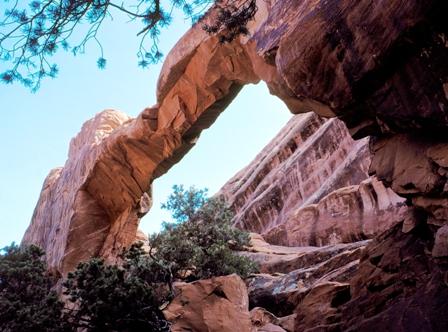One minute it was there, the next it was gone.
The collapse of "Wall Arch" at Arches National Park proves once again that gravity does work, even though you might wonder after gazing at the "rockitecture" of this dazzling Utah park.
Wall Arch, long a key attraction along the park's Devils Garden Trail, collapsed sometime overnight August 4. And since rock has continued to peel off of the collapsed arch, officials have been forced to temporarily close the popular trail just beyond Landscape Arch.
On Thursday representatives from both the National Park Service Geologic Resources Division and the Utah Geological Survey visited the site and noted obvious stress fractures in the remaining formation. Rock debris has completely blocked this section of the trail. The closure will remain in effect until visitor safety issues can be resolved.
First reported and named by Lewis T. McKinney in 1948, Wall Arch was a free-standing arch in the Slickrock member of the Entrada sandstone. The opening beneath the span was 71-feet wide and 33-1/2 feet high. It ranked 12th in size among the over 2,000 known arches in the park.
All arches are but temporary features and all will eventually succumb to the forces of gravity and erosion. While the geologic forces that created the arches are still very much underway, in human terms it’s rare to observe such dramatic changes.
No one has reported observing the arch collapse and there were no visitor injuries.




Comments
This was not a funtion of global warming. Nor were the formation of the Arch itself due to global warming. Time and mother nature took it's normal course of action.
except for the fact that cinder cone has only been in existance since the mid 1800's! I witnessed the vast changes since I last visited in the 1980's. It had eroded more in the last 20 years than in the previous 130. What has happened to reading comprehension inis younger generation?
Check out the Natural Arch and Bridge Society, which names Landscape Arch as the longest natural rock span on earth. Now that's "iconic." http://www.naturalarches.org/big9.htm
Chance:
Actually, the largest concentration of natural arches in the United States outside of Arches National Park are the Rattlesnake Arches in Colorado's McInnis Canyons National Conservation Area and the Black Ridge Canyons Wilderness, not far from Arches NP. Find more info here: http://www.blm.gov/co/st/en/fo/mcnca/recreation/hiking/rattlesnakecyn0.html
Rattlesnake Canyon is truly a sight to behold, and quite a hike from nearby Fruita, Colorado -- 16 miles roundtrip if you choose the low trailhead. The high trailhead is only accessible via 4wd vehicle.
Global warming is what created most of our NP's anyway...Love the warming,,,
I am so glad I got to see this arch this year!! It was magnificent....as well at the others being just as wonderful. On some one could tell that it won't be long before the succumb to gravity....see them while you can.
SaltSage236,
Thanks for correcting me. This is particularly useful information for me to have since I volunteer and sometimes give interpretive programs at BISO.
This arch has been sitting around for half a million years or so without falling. Of course the long term cause is gradual erosion, but I suspect the immediate cause was weather and tide related: drier than normal, coupled with shear stresses caused by a temperature gradient. Problem is, August 1 had a 40 degree differential compared to a 25 degree drop Monday night, and the new moon occurred 2 days earlier as well. The winds were stronger Friday than Monday night. Did it fall two days after it cracked? I doubt it, but there must have been some reason it fell when it did. We're a month past aphelion, with its weaker tides, but the arch has gone through the worst of a summer full of expansion and contraction. Winter freezing and thawing does the long term damage, but summer probably provides more triggering mechanisms. Ice ages may set the arches up to tumble during interstadials. I think natural global warming could be the culprit. --AGF